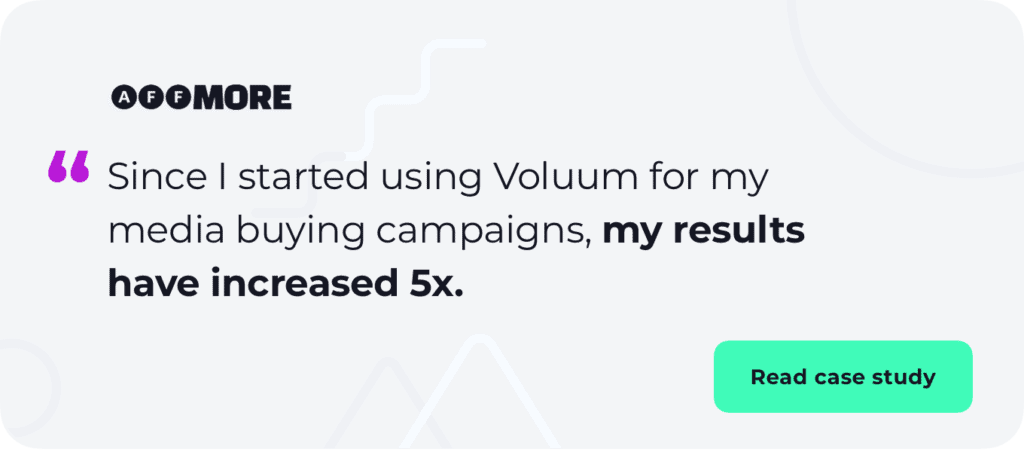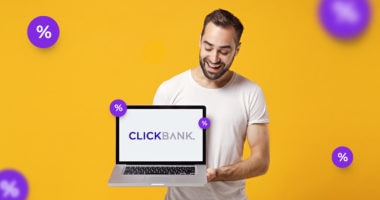Ad types work a bit like fashion: some types go in or out of the style through the years. Ten years ago, the Internet was full of pop-up or banner ads. Five years ago – the industry went crazy over push ads. Now it seems like native ads get the most tracktion. But is the current trend true? Good for all types of digital marketing campaigns? Most cost effective?
As you have probably guessed it, the answer to all these questions is ‘no’. There is no ‘one size fits all’ type of ad. When choosing and ad type, you must consider your offer type, budget, audience, and many other factors that we discuss in this article.
What type of ads are most effective?
Before discussing various types of ads, we should start discussing you. Making a decision about the best ad format for yourself kind of depends on how who that “you” the person is. More specifically, what are your skills, goals, and resources. You need to ask yourself several questions:
- What is my monthly budget? Can I spare a whopping 1000$ for testing or am I closer to the 200$ level?
- Can I do affiliate marketing full-time or part-time only?
- What marketing vertical would I like to work in? Or, at least, is it a general category or a narrow niche?
- How well do I grasp the technical concepts behind online marketing?
- What is my “thing”, am I better in writing text or in the math behind the optimization?
Be honest with yourself. This is not aimed to impress anyone, this is aimed to help you decide, what ad type will work best for you.
How many types of ads are there?
For all of you that were wondering, here’s a short answer: we can distinguish 5 types of ads, and some of them have their own sub-types.
The distinction is not clear. In-page push ads look like regular push but it is in fact a banner ad. Pop-under is not actually an ad but a landing page that opens in the background. Social are sometimes treated as a sub-type of native ads and very often a separate category of mobile ads is distinguished just because they are displayed on a concrete device type.
The main point of this article is to give you an overview of options you have, not to settle any discussions once and for all.
1. Pop ads
The first choice of every newbie. The scrambled eggs of ads.
The main reason why everyone is advised to start with pop ads is that they are good teaching material. Other types of ads may be harder to master, may require more content and generally, more awareness of how everything works. Pop ads are simple.
- You learn how to find offers
- You learn how to target your audience
- You learn how to set up tracking
With them, you can even skip creating a landing page and link directly to an offer page. The quickest results from the simplest setup.
Types of Pop Ads
Pop ads may have various formats:
- Pop-over
- Pop-under
- Banner
- Interstitial
The common denominator is that they simply pop in front of visitors’ eyes while they browse the web.
Pros od pop ads 
- If you are on a tight budget, then pop ads are a great way to start. If you cannot spare more than 200$ for testing per month, don’t go for natives, you will get burned, along with your budget.
- Pops are easy in technical terms, meaning that you don’t have to deal with layer after layer of options in a traffic source platform. Landing pages, if used, are usually rudimentary. Creatives are flashy and eye-catching. Pops are ads that don’t pretend that they are something else.
Cons of pop ads 
- The main disadvantage is, as you have probably observed from your own web-browsing experience, is that the time of pops prevalence has passed. Visitors, especially in Tier 1 countries, have developed a banner-blindness. The flashier the banner is, the more it gets ignored.
- Pop ads are still good for Tier 3 countries, but the payouts are, well,… also Tier 3.
A nice portion of scrambled eggs… every day
So, should pop ads be beginner’s first choice or not? Pop ads have been pronounced dead, on several occasions by various marketing gurus but it’s 2019 and they are still alive and kicking. Moreover, they are still bringing profits to marketers. But if you want to scale up and skip the training wheels, you might as well start with something different.
The affiliate ladder
Most affiliates tend to follow the same path when scaling up. They start with pop ads, because everyone does, and then move progressively up the ladder. The typical “affiliate ladder” looks as follows:
- Pop ads
- Push ads
- Native ads
- Social and search
- New formats, future technologies, undiscovered platforms
- Teaching others.
You might as well jump a step ahead to other types of ads if you feel confident enough.
2. Push ads
Push ads are generally closer to native ads than to pop ads, because you need to provide more content for a visitor, and you definitely need to set up a landing page. If you feel confident that you can write a piece of convincing text on a landing page, you can try push.
They are a hot topic right now. Push ads are visible only for visitors that have already given their consent for showing notifications. This separates uninterested parties, window shoppers and tire-kickers from visitors actually interested in the subject.
The alerting form of push ads grabs our pre-qualified visitors’ attention more than semi-random pops. The downside? A push ad is just an icon with a few words of text. It has to lead to more high-quality content in order to be successful. A good landing page is a must.
Types of push ads
- Push – regular push notifications, generated by mobile aps or web browsers.
- In-page push – banner ads that resemble push notifications. they are generated by a web page itself, not by a browser, and therefore it can bypass browser settings. The downside is that they are not dispalyed on a lock screen.
Pros 
- Push ads feel more personal. The original visitor’s consent required for displaying push means that these ads are kind of expected and welcomed. They make visitors grab their phones and check them out instead of making them sigh with irritation, like pops often do.
Cons 
- The tailored experience of push ads requires investing more effort and more time in the design of campaign funnels. You cannot create a successful campaign in minutes, it takes time.
- Additionally, push ads are more regulated than pop ads. Adult vertical is a no-no for many push platforms. The same goes for brand logos. Smartlinks are, how to put it… frowned upon.
- Lastly, the volume of traffic may fluctuate significantly. Sometimes all it takes is one publisher’s site going down and you experience a sudden drop in traffic.
Push yourself to be in front of visitors’ eyes
If you have already found your favorite type of ad, go with that. But if you are still shopping, but not buying, then keep reading. Remember, you don’t have to follow other affiliates that came before you up the ladder. The overall principles of affiliate marketing apply to all types of ads: pop, push, native, and so on.
All types of ads come from traffic source platforms, but they may have a different amount of options. All types of ads require a creative to be designed and content to be written, but the amount of text varies. All of them involve trackers, postbacks, tracking parameters and other ingredients. On learning one type, you will be able to work with other ad types.
3. Native ads
Native ads work two-fold: they blend in, but still stand out enough to be clicked. The landing page behind them looks like a normal article, but it has to be persuasive enough to entice a visitor.
Native ads require a more creative approach. But…
if know your audience… (you can research it),
If you know what attracts them… (you can A/B test it),
If you know what works… (you can learn from others),
…then go with native. They require more effort, more preparation, more of everything. They require a person that takes the stairs when everybody uses the escalator, a person that wants to learn how to drive manually. Or to use my brilliant cooking analogy, a person that is not afraid to prepare a turkey dinner for eight people as their first cooking task.
Pros of native ads 
- Native ads offer high payouts. Ten times more than what you may expect from pops or push. One conversion and you get enough money for a decent meal in a restaurant, or even several ones.
- The other thing is that they are future-proof. At some point in time, somewhere in a headquarter of an Internet behemoth, there will be a decision. Shortly after, there will be a small update of software following that decision, which will block or at least limit pops and push as being too intrusive.
- It’s not a question of “if”, but of “when”. Better start getting used to the brave new world without pops and push.
Cons of native ads 
- The already mentioned downside is the amount of work required to get a successful conversion. Sometimes a landing page has to look like a legitimate news portal, full of categories, subsections, and widgets. All that for one crypto-enthusiast’s click.
- Taking that into consideration, you may still look for alternative types of ads that can fund your restaurant meal.
4. Search Ads
To keep up with my inconsistent cooking metaphor, search ads are like meals served by a personal cook. Imagine that this cook crawls inside someone’s head, overhears that all they want is a meatball spaghetti, and serves them just that. You can be that cook.
You don’t have to actually crawl into anyone’s head. Someone is already there: Google. Listening to our shameful search queries and taking notes. If there’s one entity that knows what users actually want, it’s Google.
Pros 
- This type of ad is perfect for a newbie that knows their audience by heart, has a very specific offer, and needs to match them both in the most efficient way possible. These ads will be shown to a user that is actively looking for something. Such user is more willing to spend.
Cons 
- Internet behemoths are harsh mistresses. They have a lot of guidelines to follow and may lock you out of your account even if you run the whitest of the white hat campaigns. Many verticals are out of the question.
- The content has to be of good quality, not to mention mastering the one thousand targeting options that most of them have will take several “How To” guides to read.
5. Social Ads
Do you want to ride the newest wave of a social craze, the TikTokest app out there? Or do you want to take advantage of Facebook’s all-knowingness and its users’ exhibitionism? Do you want to capitalize on the dreams of the ideal life presented on Instagram?
These ads go where the center of social gravity is. With the plethora of targeting options, they allow you to show what users actually want.
Pros 
- Social ads are the most contextual type of ads. That means that they are the most connected with a user’s persona. No more blindly targeting iPhone users from Chicago, with this type of ad you can target almost individual people with the precision of a watchmaker.
Cons 
- The cons are similar to the search ads: there are tons of options to dig through, which could discourage a less diligent person.
- Further to that, social platforms have very strict rules about what you can advertise and these rules are enforced by people wanting to be on the safe side. This means that your campaign or even the whole account may get banned at any time, without any warning, and sometimes with no apparent reason. Tread lightly.
Types of ads for all
You may have already guessed it, but there isn’t one formula for all. What a boring world that would be. Instead, you can carve out your own path.
- The steady path of a pops lover.
- The exciting path of a push enthusiast.
- The glorious path of a native believer.
- The promising path of a search warrior.
- The inspiring path of a social leader.
Whichever path you follow, it is always good to have an affiliate ad tracker to count on…








3 comments
Hey Michal,
Great Blog Post!! Even I have to start affiliate marketing but was confused about all the questions you listed above. Can you suggest the best affiliate marketing sites?
Very interesting post, in this blog you described very well. Thank you for sharing this wonderful post.
Very useful post.